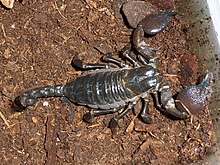Sclerotin is a component of the cuticles of various Arthropoda, most familiarly insects. It is formed by cross-linking members of particular classes of protein molecules, a biochemical process called sclerotization. Technically it amounts to a form of tanning. The resulting material adds physical stiffness to the toughness of an insect's chitinous exoskeleton. It is particularly prominent in the thicker, armoured parts of insect and Arachnid integument, such as in the biting mouthparts and sclerites of scorpions and beetles.
As it matures, freshly formed sclerotin becomes a hard, horn-like substance with a range of yellow-brown colors. As animals adapted to life on land, increasingly diverse needs for organic stiffening components arose (as opposed to mineral stiffening components such as calcium carbonates and phosphates). Among the invertebrates this need was met largely by the development of sclerotins and other cross-linked proteins that allowed insects to adapt to existence on the land and later to develop wings.
Sclerotin is biochemically variable; different species incorporate different proteins in different proportions, and the same insect will use different compositions in forming the different components of its body. For example, the stiffening of the biting surfaces of a locust's hard mandibles will not be the same as the stiffening of its springy hind tibiae. In general however, it is formed by cross-linking the various protein molecules with phenolic compounds; a tanning process under enzymatic control. In some of the Apterygota however, at least some of the cross-linking is by disulphide bonds reminiscent of protein cross-linking in the formation of keratin. This has led many authors to refer to such cross-linked proteins in invertebrates as keratin, but modern analyses have shown that the term is inappropriate; keratins are a fairly well-defined set of proteins comprising particular chains in different proportions cross-linked in particular ways. Invertebrate connective tissues proteins based on disulphide links appear to be radically different.
See also

- Sclerite
References

- ^ Klots, Alexander B.; Klots Elise B. (1977). 1001 Questions Answered About Insects. Courier Dover Publications. p. 29. ISBN 0486234703.Â
- ^ Wigglesworth, Vincent Brian (1984). Insect Physiology. Springer. ISBN 0412264609.Â
- ^ Richards, O. W.; Davies, R.G. (1977). Imms' General Textbook of Entomology: Volume 1: Structure, Physiology and Development Volume 2: Classification and Biology. Berlin: Springer. ISBNÂ 0-412-61390-5.Â
- ^ Weber, Klaus et al; "Amino acid sequences and homopolymer-forming ability of the intermediate filament proteins from an invertebrate epithelium"The EMBO Journal vol.7 no.10 pp.2995-3001, 1988
- ^ BROWN, C. H.; Keratins in Invertebrates; Nature 166, 439 (09 September 1950); doi:10.1038/166439a0
